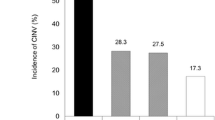Abstract
Nausea and vomiting that are induced by chemotherapy have a negative impact on the health-related quality of life of affected patients, can cause potentially serious complications and may deter patients from further chemotherapy treatment. Appropriate use of prophylactic regimens may help to minimize the incidence of such nausea and vomiting. Selection of prophylaxis should be based on patient- and chemotherapy-related factors.

Similar content being viewed by others
References
Navari RM. Management of chemotherapy-induced nausea and vomiting: focus on newer agents and new uses for older agents. Drugs. 2013;73(3):249–62.
NCCN clinical practice guidelines in oncology (NCCN Guidelines®): antiemesis (version 1.2013). Fort Washington: National Comprehensive Cancer Network®, Inc., 2012.
Morrow GR, Roscoe JA, Kirshner JJ, et al. Anticipatory nausea and vomiting in the era of 5-HT3 antiemetics. Support Care Cancer. 1998;6(3):244–7.
Roila F, Herrstedt J, Aapro M, et al. Guideline update for MASCC and ESMO in the prevention of chemotherapy- and radiotherapy-induced nausea and vomiting: results of the Perugia consensus conference. Ann Oncol. 2010;21(Suppl 5):v232–43.
Basch E, Prestrud AA, Hesketh PJ, et al. Antiemetics: American Society of Clinical Oncology clinical practice guideline update. J Clin Oncol. 2011;29(31):4189–98.
Eisenberg P, Figueroa-Vadillo J, Zamora R, et al. Improved prevention of moderately emetogenic chemotherapy-induced nausea and vomiting with palonosetron, a pharmacologically novel 5-HT3 receptor antagonist: results of a phase III, single-dose trial versus dolasetron. Cancer. 2003;98(11):2473–82.
Gralla R, Lichinitser M, Van Der Vegt S, et al. Palonosetron improves prevention of chemotherapy-induced nausea and vomiting following moderately emetogenic chemotherapy: results of a double-blind randomized phase III trial comparing single doses of palonosetron with ondansetron. Ann Oncol. 2003;14(10):1570–7.
Aogi K, Sakai H, Yoshizawa H, et al. A phase III open-label study to assess safety and efficacy of palonosetron for preventing chemotherapy-induced nausea and vomiting (CINV) in repeated cycles of emetogenic chemotherapy. Support Care Cancer. 2012;20(7):1507–14.
Longo F, Mansueto G, Lapadula V, et al. Combination of aprepitant, palonosetron and dexamethasone as antiemetic prophylaxis in lung cancer patients receiving multiple cycles of cisplatin-based chemotherapy. Int J Clin Pract. 2012;66(8):753–7.
Grunberg S, Chua D, Maru A, et al. Single-dose fosaprepitant for the prevention of chemotherapy-induced nausea and vomiting associated with cisplatin therapy: randomized, double-blind study protocol-EASE. J Clin Oncol. 2011;29(11):1495–501.
Navari RM, Einhorn LH, Passik SD, et al. A phase II trial of olanzapine for the prevention of chemotherapy-induced nausea and vomiting: a Hoosier Oncology Group study. Support Care Cancer. 2005;13(7):529–34.
Navari RM, Einhorn LH, Loehrer PJ Sr, et al. A phase II trial of olanzapine, dexamethasone, and palonosetron for the prevention of chemotherapy-induced nausea and vomiting: a Hoosier oncology group study. Support Care Cancer. 2007;15(11):1285–91.
Tan L, Liu J, Liu X, et al. Clinical research of olanzapine for prevention of chemotherapy-induced nausea and vomiting. J Exp Clin Cancer Res. 2009;28:131.
Navari RM, Nagy CK, Gray SE. The use of olanzapine versus metoclopramide for the treatment of breakthrough chemotherapy-induced nausea and vomiting in patients receiving highly emetogenic chemotherapy. Support Care Cancer. 2013;21(6):1655–63.
Meiri E, Jhangiani H, Vredenburgh JJ, et al. Efficacy of dronabinol alone and in combination with ondansetron versus ondansetron alone for delayed chemotherapy-induced nausea and vomiting. Curr Med Res Opin. 2007;23(3):533–43.
Fein LE, Poma A, Hedley ML. Efficacy and safety of rolapitant, a novel NK-1 receptor antagonist, for the prevention of chemotherapy-induced nausea and vomiting in subjects receiving highly emetogenic chemotherapy [abstract no. 9077]. J Clin Oncol. 2012;30(15 Suppl).
Rossi G, Tilkola SO, Rudengren C. A positron emission tomography study to assess the degree of neurokinin-1 receptor occupancy in the human brain after single doses of netupitant to healthy male subjects [abstract no. 9054]. J Clin Oncol. 2012;30 (15 Suppl).
Cruz FM, de Iracema Gomes Cubero D, Taranto P, et al. Gabapentin for the prevention of chemotherapy-induced nausea and vomiting: a pilot study. Support Care Cancer. 2012;20(3):601–6.
Disclosure
This article was adapted from Drugs 2013;73(3):249–62 [1]. The preparation of these articles was not supported by any external funding.
Author information
Authors and Affiliations
Consortia
Rights and permissions
About this article
Cite this article
Adis Medical Writers. Minimize and manage the occurrence of chemotherapy-induced nausea and vomiting with a carefully selected prophylactic regimen. Drugs Ther Perspect 29, 210–214 (2013). https://doi.org/10.1007/s40267-013-0049-5
Published:
Issue Date:
DOI: https://doi.org/10.1007/s40267-013-0049-5



